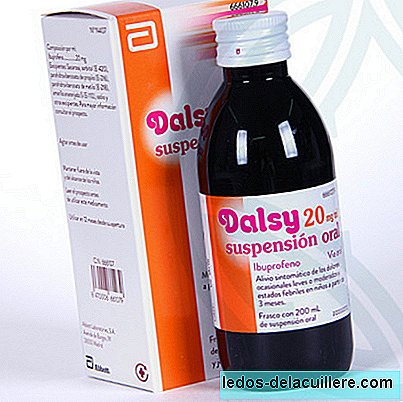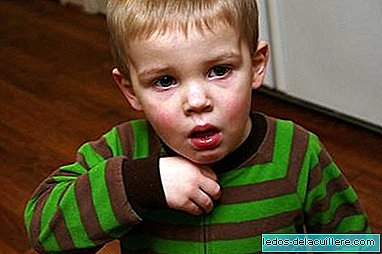
The Spanish Agency for Medicines and Health Products (AEMPS) has published a response to the complaint raised by FACUA requesting that the side effects of the E-110 dye that would be omitted in the leaflet of 'Dalsy' ibuprofen syrup be included 20 mg / ml The petition referred to the fact that, according to Regulation (EC) 1333/2008 of the European Parliament on food additives, this dye could have negative effects on the activity and care of children.
After evaluating for a few days the information contained in the leaflet of the drug Dalsy 20 mg / ml, AEMPS has announced that it will not be modified and that "there is no reason for the alarm".
AEMPS statement
As we collect from the official site of the AEMPS
The content of E-110 dye in the drug Dalsy 20 mg / ml, oral suspension, makes It is highly unlikely that doses will be reached that are even close to the acceptable daily intake. for the content of this dye in food. Therefore, it is considered that the information currently contained in the data sheet, labeling and leaflet of the medicine It is adequate and there is no reason for the alarm.
Since it is a drug widely used in pediatrics, it is intended reassure parents about the dye contained in it.
The Spanish Agency for Medicines and Health Products (AEMPS) has reassessed in recent days the information contained in the leaflet of the drug Dalsy 20 mg / ml, oral suspension, in relation to its content of the orange-yellow dye (E-110) (1 ). It is a widely used medication in an age segment that ranges from infants older than 3 months to children 12 years old for symptomatic relief of occasional mild or moderate pain, as well as in febrile conditions.
Various information has echoed a letter sent to the Agency on September 6 in which the inclusion of the potential effect of this type of azo dye on behavior in children was requested in the package leaflet. In this regard, given that the letter has been made public in the media before the response from the Agency, and in order to reassure users regarding the use of this or other medications containing the same dye, The Agency wants to make public the results of its evaluation:
1) Regulation (EC) No. 1333/2008 of the European Parliament and of the Council, of December 16, 2008, on food additives that has been cited applies to those additives in the food sector.
2) The regulations applicable to medicines (2) establish the obligation to include, at least qualitatively, all the excipients contained in the medicines. In addition, for those excipients that have a known action or effect (called mandatory declaration excipients) it is necessary to include the content in quantitative terms. The mandatory declaration excipients are detailed in the annex to the European Commission's Directive of excipients (3), which are common to the European Union. When a certain medicine contains any of the excipients detailed in this guideline, it is necessary to include in the product information the warnings or contraindications, if any, which are detailed in this annex.
In this line, the current leaflet of Dalsy 20 mg / ml, oral suspension, details its sucrose, sorbitol (E-420), methyl parahydroxybenzoate (E-218) and propyl parahydroxybenzoate (E-216), sodium and Orange yellow dye S (E-110), each with its corresponding warning that in the case of dye E-110 is that it can cause allergic reactions and can cause asthma, especially in patients allergic to acetylsalicylic acid (4).
It contains an amount of the E-110 dye well below the allowable intake
3) The content of the orange-yellow dye S (E-110) that can be ingested with the recommended daily maximum doses of Dalsy 20 mg / ml, oral suspension, is well below the allowable daily intake of this product according to the legislation of food additives, which is currently 4 mg / kg weight / day (5). Specifically It represents about 6% of the allowable daily intake For this product.
Moreover, these values are well below the amounts that were tested in the McCann et al (6) trial that served as the basis for the evaluation that the European Food Safety Authority (EFSA) led to In 2009, on the effect of certain dyes and sodium benzoate on the behavior of children (7) and whose results are inconclusive. The evaluations carried out by other health authorities such as the Food and Drug Administration (FDA) in the United States have similar conclusions regarding the difficulty in drawing definitive conclusions (8).
Health clarifies that the information contained in the leaflet of the medicines refers to the effects derived from its use under recommended conditions and even in overdose conditions, but in this case it would be intended to include in cases in which it would be very difficult to overdose:
4) Taking into account all of the above, and even without considering the effects of the intake of an amount of E-110 dye equivalent to the maximum allowable intake, to reach that amount it would be necessary not to have an intake higher than that recommended in the medicine's data sheet but even higher than that obtained with several bottles of the medicine, and all this not only acutely but continuously over time. In this regard, it should be noted that the information contained in the medicinal product leaflet refers to the effects derived from its use under recommended conditions and even in overdose conditions, but never in conditions where it is very difficult to reach that dose.
Therefore includes allergy warning, likely to occur at any dose administered, and excludes the effects of the dye that could only occur if you drink two bottles of the medicine.
For this reason the product information refers to the possibility of allergic reactions, something that can occur in people susceptible to virtually any dose, and does not refer to the possible effects on behavior in children, something on which the available evidence does not is conclusive and that it would occur at doses that are impossible to achieve even in case of overdose With a single medicine container.
5) In view of the above, it is considered that the information currently contained in the datasheet and labeling and leaflet of Dalsy 20 mg / ml oral suspension is adequate. However, in case of having conclusive scientific evidence on the negative effects of this dye on the activity and attention of children, the authorized information would be updated through the usual channels. The Agency wants to send a message of tranquility to all users of this and other medications that may contain the E-110 dye and recalls the importance of notifying all suspected adverse reactions to the corresponding Autonomous Pharmacovigilance Center of the Spanish Pharmacovigilance System, being able to also notify through the electronic form available on the website www.notificaRAM.es.
Pediatricians continue to recommend it

Following FACUA's complaint, the pediatricians spoke in the same way as the AEMPS then ratified in the statement. They argue that Dalsy syrup does not represent any risk and remains safe for children, since the dye doses contained are minimal to be considered a risk to their health.
As the EFSA (European Food Safety Authority) has reconsidered The allowable daily intake (ADI) of the E-110 dye is of 4 mg / kg / day. A 10-kilogram child should drink 400 ml of Dalsy to match the maximum intake, the equivalent of two bottles of syrup per day (the bottle contains 200 ml).
Via | AEMPS
In Babies and more | Too many mothers abuse ibuprofen: how to avoid misuse?
In Magnet | How do dyes like Dalsy E-110 affect us?












